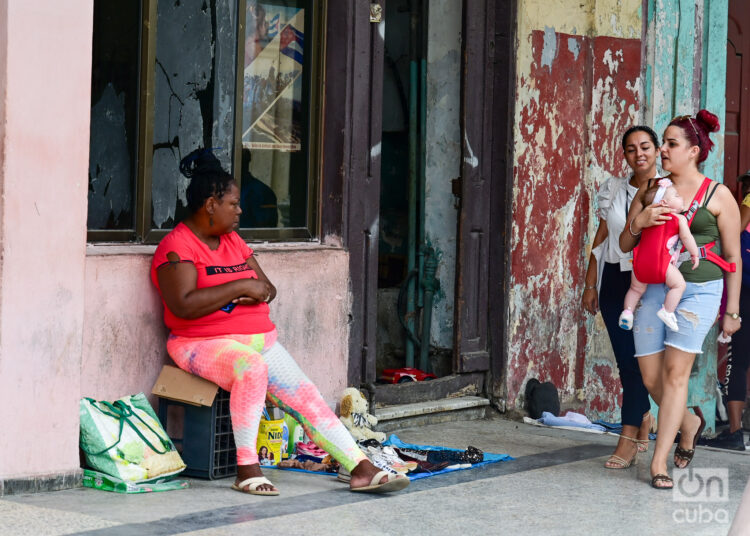The “polycrisis” that has taken root in Cuba over the last five years has progressively widened social inequalities along economic, racial, territorial, age and gender lines, three Cuban sociologists explain in a joint interview with EFE news agency.
This phenomenon is generating tensions in a country characterized for decades by extreme egalitarianism, and the government must respond with new solutions, argue these experts from the state-run Center for Psychological and Sociological Research (CIPS).
“Inequality is the main effect of the polycrisis,” says Enrique Gómez Cabezas, coordinator of the Social Policy and Inequalities Group.
Shortages and difficulties in multiple areas overlap, intertwine, and feed off each other, preventing the intuition of a solution as far as the eye can see.
Blackouts of up to 20 hours a day paralyze factories, offices, agriculture and homes; public transportation is at a standstill without fuel; liquefied gas cylinders for cooking are in short supply; pharmacies are almost empty; basic products like bread are being rationed.… It’s a “daily life of shortages,” according to Gómez Cabezas.
Mirlena Rojas Piedrahita, coordinator of the Network of Sociological Studies on Labor, believes that this “polycrisis” is a “trait of the times” that “imprints a fundamental characteristic on current Cuban society.”
“Sometimes the word resilience falls far short for me. I still can’t find the word that one might sometimes use when considering survival strategies,” notes this sociologist, who believes that this context generates an “uncertainty” that “produces and reproduces” states of stress.
Although the situation doesn’t affect everyone equally, she adds. There are those who have been able to access the more dynamic and better-paid private sector, those who can afford a generator for power outages, and those who have the resources to move to another country.
Social re-stratification
These inequalities, according to these sociologists, began to emerge with the timid but liberalizing reforms introduced by former President Raúl Castro starting in 2011, the so-called “updating.”
Rojas explains that an “opportunity structure” for socioeconomic development was put in place, but notes that “there were people who could access” and improve their quality of life, “and others who couldn’t.” This led to a process of social re-stratification.”
The Gini coefficient, the main indicator of social inequality, has fallen from 0.25 (out of a maximum of 1) in 1989 to between 0.4 and 0.5 today, according to conservative official calculations, which would place Cuba in the average of Latin American countries, between Argentina and Panama.
Rojas and Gómez Cabezas, however, distance themselves from those who point to a “Latin Americanization” of Cuba, because although some indicators — such as the Gini index — have worsened in recent years (from infant mortality to poverty and crime), they still perceive quantitative and qualitative differences.
“We’re getting closer to some realities, but we’re still far from them,” Rojas points out.
Gómez Cabezas points out that in Cuba, unlike other Latin American countries, healthcare is, by principle, universal and free, and that there’s no doubt about that, although its application is limited.
But that’s not enough, Gómez Cabezas adds. In his opinion, the Cuban government must update its laws to enforce the principles of equity and social justice. “These policies must be more responsive to the current context,” he affirms.
“Even if they are universal policies, they are not enough to prevent the reproduction of inequalities. There are sectors that are better off and will monopolize the best opportunities for themselves. And other sectors will be left behind, (thus) reproducing and amplifying these disadvantages,” he explains.
He advocates ending homogeneous policies and focusing on “affirmative action,” “managing equity at the local level,” and “targeting.”
“We must recognize existing inequality,” insists Gómez Cabezas.
Crisis and daily life in Cuba: What does street sociology say?
A decade of unprecedented emigration
The “updating” reforms and the “deterioration” of public services, Gómez Cabezas continues, have led to “the displacement of responsibilities previously covered by social policy toward the family” or to “individual-family strategies” to meet needs.
One of these strategies, perhaps the most visible and consequential, is emigration. Cuba is experiencing an unprecedented wave of migration, the largest in volume and duration in decades, with the departure of between 14 and 25% (official data and independent estimates, respectively) of the population in just four years.
“Recognition of migration as an alternative for economic improvement has grown,” notes Gómez Cabezas, adding that it was previously perceived as something negative, but now Cuban society has “naturalized” this option and more and more people are identifying it as a possibility.
Jusmary Gómez Arencibia, coordinator of the Cuban Network of Social and Solidarity Economy and Corporate Social Responsibility, points out that the “deterioration” of certain public services, such as education and healthcare, has begun to become a reason for migration.
She also emphasizes that migration used to be primarily a “family” strategy — a family member was chosen based on his/her characteristics to leave — while now it is more of an individual decision.
But not everyone who wants to can, due to growing inequalities. The key to be able to migrate, these experts agree, is the economic factor, which, in their opinion, is a disadvantage for Afro-Cubans.
“Migration has its color,” Rojas adds.
________________________________________
Juan Palop/EFE










